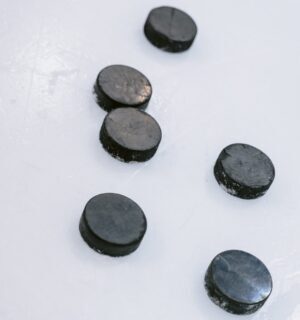In the thrilling world of ice hockey, one element often overlooked but undeniably crucial to the game is the humble puck. A small, flat disk made of vulcanized rubber, the puck is the focal point of every match, propelling itself across the icy surface with incredible speed and precision. In this article, we will delve into the history, design, and significance of the ice hockey puck.
History of the Puck:
The origins of the hockey puck can be traced back to the early days of the sport. Before standardized pucks, players often used various objects, including wooden blocks and even balls, for the game. The first recorded instance of a standardized puck dates back to the late 19th century when the game was rapidly gaining popularity in North America.
Early pucks were made of wood, but these quickly gave way to rubber for its superior durability and bounce. The modern vulcanized rubber puck became the standard, offering consistent performance and durability. Today’s pucks adhere to strict regulations regarding size, weight, and materials to ensure fair and uniform gameplay.
Design and Specifications:
A standard ice hockey puck has a diameter of 3 inches (76 millimeters) and a height of 1 inch (25 millimeters). It weighs approximately 6 ounces (170 grams). The puck is designed to slide effortlessly across the ice, allowing for swift and precise movements during the game.
The bottom surface of the puck is flat to enhance stability and control. Additionally, the puck features a series of ridges on its sides, which aid players in handling and shooting. These ridges create a textured surface for better grip and control, enabling players to execute intricate maneuvers with ease.
The black color of the puck provides a stark contrast against the white ice, making it highly visible to players and spectators alike. This visibility is crucial in the fast-paced environment of ice hockey, where split-second decisions can determine the outcome of a game.
Significance in Gameplay:
The puck is the focal point of every ice hockey match, acting as the catalyst for goals, assists, and strategic plays. Players utilize their sticks to maneuver the puck, passing it among teammates, defending against opponents, and ultimately attempting to score goals by propelling the puck into the opposing team’s net.
Shots and passes are executed with precision, with players relying on their skill and experience to control the puck’s trajectory. The puck’s small size and rapid movement demand quick reflexes and a high level of hand-eye coordination from players, adding an extra layer of excitement to the sport.
While often overshadowed by the flashy moves and impressive athleticism of the players, the ice hockey puck is undeniably the unsung hero of the game. Its design, history, and significance in gameplay contribute to the thrilling spectacle that is ice hockey. The puck’s unassuming nature belies its critical role in the sport, and without it, the fast-paced, exhilarating game of ice hockey as we know it would simply not exist.


